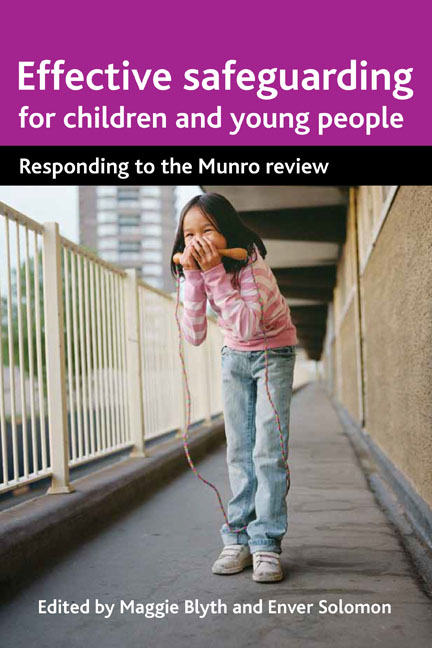Book contents
- Frontmatter
- Contents
- List of abbreviations
- Notes on contributors
- Acknowledgements
- Foreword
- Introduction Introduction
- one Early intervention
- two Local safeguarding children boards: faith, hope and evidence
- three The child's voice in the child protection system
- four Parental mental health, risk and child protection: what does Munro mean to child protection and adult mental health?
- five Adolescent-to-parent abuse and frontline service responses: does Munro matter?
- six Older children and the child protection system
- seven Serious case review
- Index
Introduction - Introduction
Published online by Cambridge University Press: 07 September 2022
- Frontmatter
- Contents
- List of abbreviations
- Notes on contributors
- Acknowledgements
- Foreword
- Introduction Introduction
- one Early intervention
- two Local safeguarding children boards: faith, hope and evidence
- three The child's voice in the child protection system
- four Parental mental health, risk and child protection: what does Munro mean to child protection and adult mental health?
- five Adolescent-to-parent abuse and frontline service responses: does Munro matter?
- six Older children and the child protection system
- seven Serious case review
- Index
Summary
There have been many pivotal moments in the recent history of child protection. In the past few years, they have followed the tragic death of a young child and led to wide-ranging reviews, most recently the Laming Inquiry in 2009 following the death of Baby Peter in Haringey. However, the independent review of child protection by Professor Eileen Munro, which concluded in May 2011, was initiated as a response to a change in government policy. Government ministers responded swiftly to Munro's recommendations in July 2011, broadly accepting that all her proposals would be dealt with ‘in the round’ (DfE, 2011). To many working in the sector, this feels like a critical point when child protection could take a different direction. There are, clearly, many questions to be raised and lots of points for discussion. This volume intends to provide space for these to be aired and to help all interested parties think though the implications of the Munro Review and the government's response.
There are three core themes to the contributions. First, solid evidence has to be the driver for good policy. This applies to understanding what works in child protection and can be implemented by local authorities and their partners. Second, any review of the child protection system in this country must focus on the child rather than the system. And third, the effective protection of children and young people involves sound judgements of risk at both a practice and organisational level. Working predominantly with very vulnerable children, this last proviso can present challenges to everyone within children's services, particularly at a time when the reorganisation of public services is impacting on the configuration of resources at the ‘front door’. Moreover, changes to the health economy, reforms to education and the reorganisation facing some police public protection teams will inevitably compound what Professor Munro has described as a ‘commonly held belief that the complexity and associated uncertainty of child protection work can be eradicated’ (Munro, 2011b).
In May 2011, Professor Eileen Munro published her final report in her review of the child protection system. A child-centred system(Munro, 2011b) makes a number of recommendations for government and the multi-agency child protection system. In July 2011, the government responded to the 15 recommendations Munro identified for reform by adopting all the principles she proposed for an effective child protection system (DfE, 2011).
- Type
- Chapter
- Information
- Effective Safeguarding for Children and Young PeopleWhat Next after Munro?, pp. 1 - 8Publisher: Bristol University PressPrint publication year: 2012



